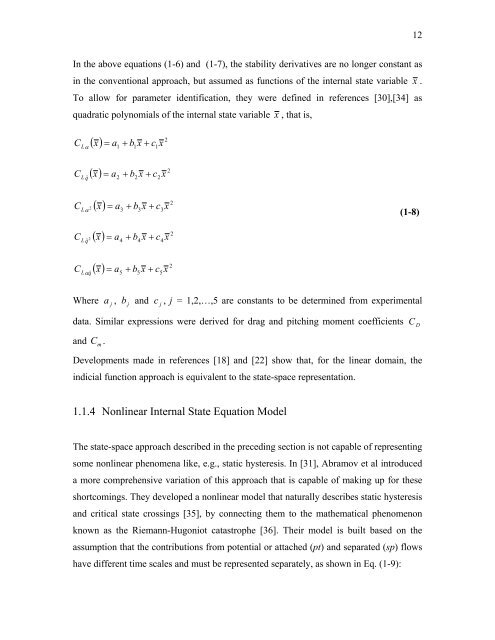Aircraft Stability Analysis Including Unsteady Aerodynamic Effects
Aircraft Stability Analysis Including Unsteady Aerodynamic Effects
Aircraft Stability Analysis Including Unsteady Aerodynamic Effects
You also want an ePaper? Increase the reach of your titles
YUMPU automatically turns print PDFs into web optimized ePapers that Google loves.
12In the above equations (1-6) and (1-7), the stability derivatives are no longer constant asin the conventional approach, but assumed as functions of the internal state variable x .To allow for parameter identification, they were defined in references [30],[34] asquadratic polynomials of the internal state variable x , that is,2( x) = a + b x cC L+α1 1 1x2( x) = a + b x c xC L q ˆ2 2+2( x) = a + b x cC L+2 x2α 3 3 3(1-8)( x2) = a + b x c xC L qˆ 24 4+CLα q ˆ2( x) a + b x + c x=5 5 54Where a , b and c , j = 1,2,…,5 are constants to be determined from experimentaljjjdata. Similar expressions were derived for drag and pitching moment coefficientsC DC mand .Developments made in references [18] and [22] show that, for the linear domain, theindicial function approach is equivalent to the state-space representation.1.1.4 Nonlinear Internal State Equation ModelThe state-space approach described in the preceding section is not capable of representingsome nonlinear phenomena like, e.g., static hysteresis. In [31], Abramov et al introduceda more comprehensive variation of this approach that is capable of making up for theseshortcomings. They developed a nonlinear model that naturally describes static hysteresisand critical state crossings [35], by connecting them to the mathematical phenomenonknown as the Riemann-Hugoniot catastrophe [36]. Their model is built based on theassumption that the contributions from potential or attached (pt) and separated (sp) flowshave different time scales and must be represented separately, as shown in Eq. (1-9):
















